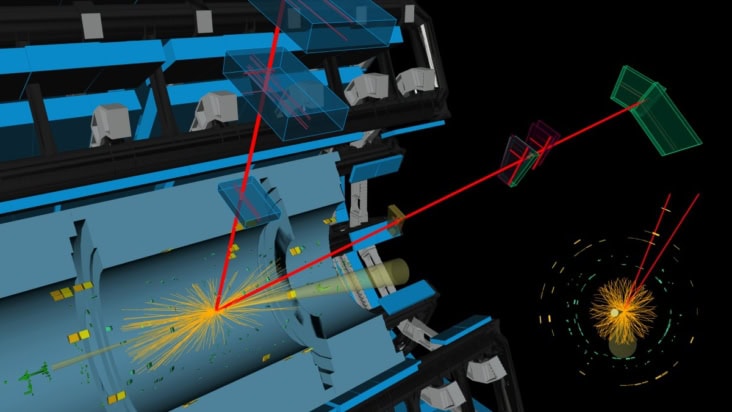

Want more in this topic? Physics World now has a newsletter dedicated to particle and nuclear physics. To sign up, go to My account then click on "My alerts".
Accelerator could be used to generate an intense beam of neutrinos

GeV-scale bremsstrahlung from an electron accelerator can be used to produce copper-64 and copper-67
.
Fourth flavour not seen in beta-decay and oscillation
 Read article: Sterile neutrinos: KATRIN and MicroBooNE come up empty handed
Read article: Sterile neutrinos: KATRIN and MicroBooNE come up empty handed
Work on radium monofluoride could shed light on the asymmetry of matter and antimatter in the universe
 Read article: Physicists use a radioactive molecule’s own electrons to probe its internal structure
Read article: Physicists use a radioactive molecule’s own electrons to probe its internal structure
High-precision laser spectroscopy measurements on the thorium-229 nucleus could reveal new physics, say TU Wien physicists
 Read article: Looking for inconsistencies in the fine structure constant
Read article: Looking for inconsistencies in the fine structure constant
Measurement discounts loss from plasma instabilities
 Read article: Accelerator experiment sheds light on missing blazar radiation
Read article: Accelerator experiment sheds light on missing blazar radiation
Having more antimatter could help solve profound mysteries of physics
 Read article: Sympathetic cooling gives antihydrogen experiment a boost
Read article: Sympathetic cooling gives antihydrogen experiment a boost
Gravitational waves confirm predictions of Einstein and Kerr
 Read article: Rapidly spinning black holes put new limit on ultralight bosons
Read article: Rapidly spinning black holes put new limit on ultralight bosons
From the Higgs boson at CERN to nuclear reactions inside stars, who doesn’t love particle and nuclear physics? There’s so much exciting work going on in both fields, which is why we’re bringing you this new free-to-read digital issue of the Physics World Particle & Nuclear Briefing.

The US High Energy Physics Advisory Panel has been dissolved for reasons of politics, not efficiency, says Robert P Crease
 Read article: Is Donald Trump conducting a ‘blitzkrieg’ on science?
Read article: Is Donald Trump conducting a ‘blitzkrieg’ on science?
Research could lead to ultracompact muon sources for applications such as tomography
 Read article: Portable source could produce high-energy muon beams
Read article: Portable source could produce high-energy muon beams
Robert P Crease examines a new example of “rant lit” from Danish theorist Jesper Grimstrup
 Read article: Jesper Grimstrup’s The Ant Mill: could his anti-string-theory rant do string theorists a favour?
Read article: Jesper Grimstrup’s The Ant Mill: could his anti-string-theory rant do string theorists a favour?
STAR collaboration homes in on critical point for quark–gluon plasma
 Read article: Hints of a boundary between phases of nuclear matter found at RHIC
Read article: Hints of a boundary between phases of nuclear matter found at RHIC
Physicists plan to test idea in the lab
 Read article: Radioactive BEC could form a ‘superradiant neutrino laser’
Read article: Radioactive BEC could form a ‘superradiant neutrino laser’
Real-time system also detects ebb and flow of tides
 Read article: Cosmic muons monitor river sediments surrounding Shanghai tunnel
Read article: Cosmic muons monitor river sediments surrounding Shanghai tunnel
The piece is currently on display at the National Museum of Stained Glass in Switzerland
 Read article: Discovery of the Higgs boson at CERN inspires new stained-glass artwork
Read article: Discovery of the Higgs boson at CERN inspires new stained-glass artwork
David Silver of Google DeepMind thinks AIs that ‘learn by experience’ are the future of AI – but maybe not in particle colliders or nuclear arsenals
 Read article: The pros and cons of reinforcement learning in physical science
Read article: The pros and cons of reinforcement learning in physical science
Robert P Crease previews the 4th International Symposium on the History of Particle Physics
 Read article: Relive the two decades when physicists basked in the afterglow of the Standard Model
Read article: Relive the two decades when physicists basked in the afterglow of the Standard Model
Observation provides new insights into the heaviest subatomic particle
 Read article: Top quarks embrace in quasi-bound toponium
Read article: Top quarks embrace in quasi-bound toponium
New atom-by-atom technique demonstrated for the first time with nobelium might ensure that elements at the bottom of the table are grouped correctly
 Read article: Making molecules with superheavy elements could shake up the periodic table
Read article: Making molecules with superheavy elements could shake up the periodic table
Benchtop accelerator links electrochemistry to fusion science
 Read article: Electrochemical loading boosts deuterium fusion in a palladium target
Read article: Electrochemical loading boosts deuterium fusion in a palladium target
Measurements could improve our understanding of the strong nuclear force and the formation of elements
 Read article: Physicists discover a new proton magic number
Read article: Physicists discover a new proton magic number
Interaction could lead to experiments that challenge the Standard Model
 Read article: Elusive scattering of antineutrinos from nuclei spotted using small detector
Read article: Elusive scattering of antineutrinos from nuclei spotted using small detector
Study of small nuclei could help us understand neutron stars
 Read article: Tritium and helium targets shed light on three-nucleon interactions
Read article: Tritium and helium targets shed light on three-nucleon interactions
Model reveals that tritium in treated water discharged from the Fukushima Daiichi reactor has negligible impact on tritium concentration in the ocean
 Read article: Global ocean simulations examine tritium release from Fukushima
Read article: Global ocean simulations examine tritium release from Fukushima
Experiment could help reveal why there is so little antimatter in the universe
 Read article: Quantum control of individual antiprotons puts the Standard Model to the test
Read article: Quantum control of individual antiprotons puts the Standard Model to the test
Andrew Glester reviews the computer game Exographer developed by SciFunGames
 Read article: Exographer: a scientific odyssey in pixel form
Read article: Exographer: a scientific odyssey in pixel form